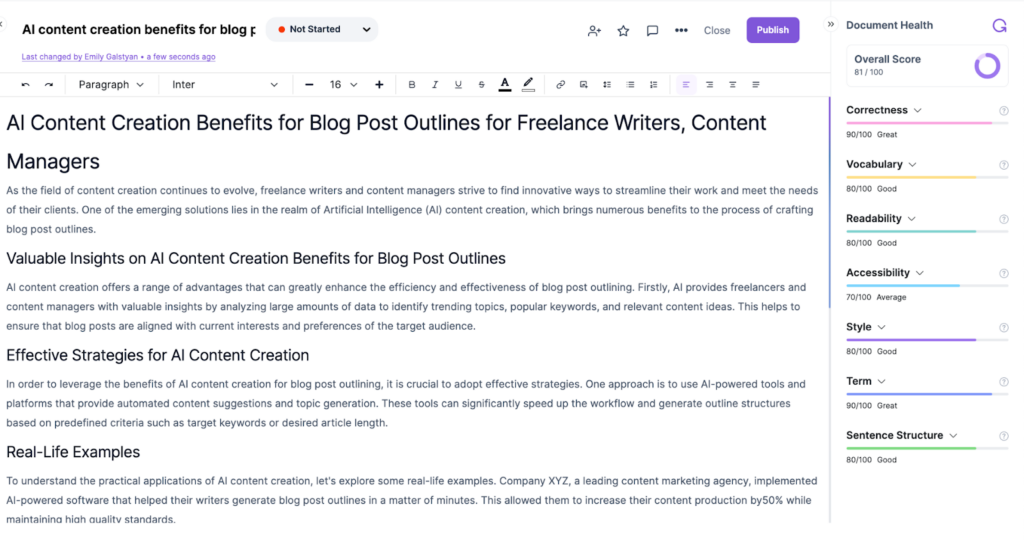Your top-ranking article on Google gets outranked by a competitor’s article within months.
Social media shifts from one viral content format to another in weeks.
With around 13 must-have content channels in 2023 and just one brain to manage them, content marketing can push your organizational skills to their limits.
But there is a silver lining — content automation, which simplifies and streamlines content production and distribution processes.
What’s this new trend that is actively used by most competitors but not yet in your bag of tricks?
Let’s break this down for better understanding.

What Is Content Automation? Key Terms Defined
Content automation is the process where tools and applications remove the need for human intervention from the content life cycle and automate it.
The traditional content development process includes many manual steps like research, ideation, planning, creation, distribution, and tracking of the content. Different teams and departments carry out all these processes, often leading to duplication of efforts, miscommunication and delays.
With content automation platform like Vocable, there’s a whole new level of efficiency and centralization. Content teams can automate and centralize that entire process within the platform.
- One can research keywords and customer-specific queries to build a content strategy around.
- Further, the team can ideate and expand on that strategy by generating new content ideas across different formats.
- Vocable will then help automatically create and assign briefs around those ideas to the team. All content team members can join the content pipeline, where they can use templates and ChatGPT to create the content.
- Lastly, the created content can be scheduled for publishing in different channels, depending on the team’s needs.
With the automated platform, content creators and managers can easily eliminate manual steps in the content workflow and scale up operations. Content teams can achieve greater efficiency with the help of automation as the process becomes more streamlined and less time-consuming.
Content Automation Glossary
Here are the key terms you’ll need to know when working with content automation tools.
Templates – pre-formatted forms containing the needed text and structure for different content types.
Content curation – selecting, organizing, and sharing relevant content from different sources.
Recycling (content repurposing) – the process of transforming one type of content (e.g., an article) into another type (e.g., an infographic). The goal is to reach different audiences and give them a new perspective ons the same idea.
Automation vs. Creativity: Striking the Right Balance for Killer Content
Data shows marketers spend around 16 hours out of a 40-hour working week on repetitive content-related tasks. These include routine tasks like scheduling emails or social media posts that are done with no creative input.
Meanwhile, repetitive tasks are the number one creativity drainer that steals time and energy from the truly important work – generating unique ideas.
By freeing creative minds from daily mundane tasks, humans can allocate more time to the creative process and bring those genius ideas to reality. And that’s exactly what content marketing automation helps to do.
In the automated content workflow, every component does what it does best.
AI finds and analyzes data at lightning speed and suggests the best options. For example, if humans need 1-3 hours to create a monthly keyword plan manually, AI can build the same plan in minutes.
Humans create emotionally engaging content ideas with empathetic focus by thinking and feeling like only humans can. They analyze AI data and make creative decisions to increase engagement. Content marketers transform AI-driven data into an engaging story by filtering the AI tool’s suggestions through a human’s creative lens.
That’s where the right balance between creativity and automation lies. If humans use content automation to add rocket fuel to their creative process, the sky’s the limit for their campaigns. Content marketers should never treat AI as a direct competitor, as that’s nearly impossible.
Instead, content automation should be treated as a precious gift of a technological evolution that allows one to focus more on strategic decisions and creativity.
Content Marketing Automation Use Cases Worth Trying Today
Let’s look at the key practical applications of content automation. For a better grasp, we’ll cite content automation examples on Vocable – an agile content automation platform.
Content Creation
Content creation involves an A-Z process, from finding topic ideas to crafting the final copy – everything that can be covered with automated tools.
First, you submit your topic to the automated solution and ask for some quick keyword research. Within minutes it will display a report with top keywords, key data such as search volume and keyword difficulty, and long-tail variations.
After researching keywords, you can add them to your content plan or use templates to create the content. This can be a blog post, YouTube caption, webinar description, or any other content type you need.
The AI-powered templates will give you a perfect structure and copy suggestions to create your content. You can then further edit and refine the drafts to make sure they are perfectly optimized and relevant.
With this approach the production for one post can take less than 30 minutes, while doing it manually could take hours.
Content Curation
An alternative to creating your content from scratch, content curation refers to finding relevant content in other creators’ sources and sharing it in your content channels for your audience. It’s not copy-pasting but an accepted way to create valuable content by weaving an engaging story around existing themes.
There are a number of principles for curating content effectively.
- Share content from different sources and always give credit to the creator.
- Maintain a balance between curated and original content in your content channels. After all, your audience wants to see your unique input as well.
- Last but not least, you can add your input to shared material by adding additional information or expressing your opinion on the topic.
Editing and Proofreading
There are around 3,500 grammar rules and 171,500 words in English. That’s a lot to remember. Except for the most frequently-used phrases and sentence structures, many content writers may need help finding the right way to express their ideas.
This is especially true for writers who have the creative skill to generate ideas but need more in-depth grammar knowledge to express them effectively. This forces companies to spend more on content production by hiring proofreaders, the most experienced of whom can review around 2,500 words in an hour, charging around $21.31 per hour.
Meanwhile, content automation tools already have large repositories of grammar and syntax rules stored in their databases. This helps them instantly recognize grammar mistakes, typos, and incorrect word usage. So, writers can correct errors in seconds and save money on manual proofreading.
Editing and Proofreading With Vocable
Vocable’s Document Health feature will help you eliminate grammar mistakes and typos in seconds and give helpful style suggestions to refine the text. It will also suggest alternative phrases to make your content sound smoother and more professional.

The AI-based editing process works for all types of content and highlights errors as you write. That way you can fix them instantly and avoid delays in content delivery.
Companies can still use manual proofreading for the final check to ensure the highest quality. However, using AI-based editing and curation tools saves 80% of the time and money that would otherwise be spent on manual processes.
Scheduling and Distribution
Publish your content on social media, blogs, newsletters, and other channels for maximum exposure. Publishing the same content in multiple places requires manual work, from creating and optimizing posts to scheduling them for delivery at the right time.
This is an easy task at its core. However, the risk of human error and consequent delays is high when it involves too much manual work and too little time.
Vocable’s scheduling and distribution feature allows you to schedule your content for multiple channels in one place, saving you a lot of time and effort. Create your content once, and it will be delivered at the selected date and time on all the channels of your choice.
The best part is that you can have a consolidated view of all the scheduled posts to ensure everything is aligned with your strategy.
Vocable’s scheduling functionality works flawlessly with all popular social media channels, allowing you to get more mileage out of your content.

Tracking and Optimization
Lastly, track and analyze your content performance. After all, the desirable “+1s” and shares are what your hard efforts are targeting.
Right now you probably do the tracking manually using a spreadsheet, and then spend more time analyzing the results. With AI-based tracking tools you can get the same results in a fraction of the time.
Automated data analytics will work behind the scenes to generate a comprehensive content performance report whenever your content is published. The data points include total reach, views, shares, clicks, and various other engagement metrics, depending on your preferred channels.
This way, you can identify the most effective content and optimize it for better future performance. Content automation tools provide a bird’s eye view of your content marketing performance that you would otherwise need to analyze manually.
This consolidated view of content performance will help you measure the ROI and identify the areas where you need to focus more. All without technical or analytical skills!
One Tool to Replace Them All | Vocable
Gone are the days when you need 10+ tools to automate content creation. There is also no need to toggle between different tools to get the desired result.
Vocable is a one-stop shop for all your content marketing needs. This content automation platform streamlines the entire content workflow – from research and planning to the professional optimization of the created content.
Vocable has built-in keyword research and content ideation tools; just submit the topic and get a multitude of ideas to write about. This means you can greatly reduce your research time and prepare content strategy quickly.
With shared access for all team members, you can comment on and approve Vocable’s generated content ideas on the go, knowing that every team member gets all the important information.
Unified Brand Guidelines for All Content Pieces
The key value of Vocable is ensuring consistency in all content pieces.
This means you can input what’s unique for your business – brand messaging, tone and voice, target audience, keywords, just once.
From then on, Vocable ensures every generated content piece strictly follows these guidelines.
This way, you don’t have to worry about misspelled words or the wrong brand voice in your content pieces – a major challenge for content teams.
One Place to Assign and Track All Content Tasks
With a few clicks, you can shift from content templates to a planner where you can manage all your content pieces.
All your team members can be invited to Vocable, and detailed briefs can be assigned to each team member. You can set deadlines, add task requirements and comments right inside the tool, as well as comment on team members’ updates.
Your team no longer has to write content in shared docs, then transfer the task details to a project management platform and wait for you to approve the updates to change everything again.
All content items are available in one place!
Always!
For all team members!

Content Automation Is The Answer!
Manual content management is a chaotic process that is time-consuming and prone to human error. What’s more, a mistake in one content piece can cost you more than the loss of your customers – it can damage your reputation and brand image.
Adding one content automation tool to your arsenal can eliminate the need for least 5-6 research, planning and management tools. This will reduce costs, save time, and, most importantly, ensure your content team works as a cohesive unit.
So, why not give it a try when you can automate content creation with just a few clicks?





